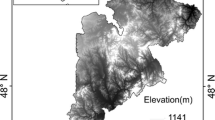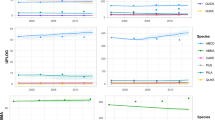Abstract
Vegetation population dynamics play an essential role in shaping the structure and function of terrestrial ecosystems. However, large uncertainties remain in the parameterizations of population dynamics in current Dynamic Global Vegetation Models (DGVMs). In this study, the global distribution and probability density functions of tree population densities in the revised Community Land Model-Dynamic Global Vegetation Model (CLM-DGVM) were evaluated, and the impacts of population densities on ecosystem characteristics were investigated. The results showed that the model predicted unrealistically high population density with small individual size of tree PFTs (Plant Functional Types) in boreal forests, as well as peripheral areas of tropical and temperate forests. Such biases then led to the underestimation of forest carbon storage and incorrect carbon allocation among plant leaves, stems and root pools, and hence predicted shorter time scales for the building/recovering of mature forests. These results imply that further improvements in the parameterizations of population dynamics in the model are needed in order for the model to correctly represent the response of ecosystems to climate change.
Similar content being viewed by others
References
Arora, V. K., and G. J. Boer, 2005: A parameterization of leaf phenology for the terrestrial ecosystem component of climate models. Global Change Biology, 11, 39–59.
Bonan, G. B., and S. Levis, 2006: Evaluating aspects of the Community Land and Atmosphere Models (CLM3 and CAM3) using a dynamic global vegetation model. J. Climate, 19, 2290–2301.
Bugmann, H. K. M., 1996: A simplified forest model to study species composition along climate gradients. Ecology, 77(7), 2055–2074.
Bugmann, H. K. M., 2001: A review of forest gap models. Climatic Change, 51, 259–305.
Cheng, G. W., and G. X. Wang, 2010: Gongga Mountain station in Sichuan. Forest Ecosystem, Vol. 3, Station Observation and Research Database of Chinese Ecosystem, China Agricultural Press, Beijing, 150pp. (in Chinese)
Cox, P. M., 2001: Description of the TRIFFID Dynamic Global Vegetation Model. Hadley Centre Tech. Note 24, Hadley Centre, Bracknell, U.K., 16pp.
Daly, C., D. Bachelet, J. M. Lenihan, R. P. Neilson, W. Parton, and D. Ojima, 2000: Dynamic simulation of tree-grass interactions for global change studies. Ecological Applications, 10(2), 449–469.
Deng, X. B., and J. W. Tang, 2010: Xishuangbanna station in Yunnan. Forest Ecosystem, Vol. 3, Station Observation and Research Database of Chinese Ecosystem, China Agricultural Press, Beijing, 380pp. (in Chinese)
Foley, J. A., S. Levis, I. C. Prentice, D. Pollard, and S. L. Thompson, 1998: Coupling dynamic models of climate and vegetation. Global Change Biology, 4, 561–579.
Friedlingstein, P., G. Joel, C. B. Field, and I. Y. Fung, 1999: Toward an allocation scheme for global terrestrial carbon models. Global Change Biology, 5, 755–770.
Friend, A. D., A. K. Stevens, R. G. Knox, and M. G. R. Cannell, 1997: A process-based, terrestrial biosphere model of ecosystem dynamics (Hybrid v3.0). Ecological Modelling, 95, 249–287.
Harcombe, P. A., 1987: Tree life tables. Bioscience, 37, 557–568.
Ise, T., C. M. Litton, C. P. Giardina, and A. Ito, 2010: Comparison of modeling approaches for carbon partitioning: Impact on estimates of global net primary production and equilibrium biomass of woody vegetation from MODIS GPP. J. Geophys. Res., 115, G04025, doi: 10. 1029/2010JG001326.
Levis, S., G. B. Bonan, M. Vertenstein, and K. W. Oleson, 2004: The Community Land Model’s Dynamic Global Vegetation Model (CLM-DGVM): Technical description and user’s guide. NCAR Technical Note, NCAR/TN-459+IA, National Center for Atmospheric Research, Boulder, NCAR, Colorado, 50pp.
Oleson, K. W., and Coauthors, 2004: Technical Description of the Community Land Model (CLM). NCAR Technical Note, NCAR/TN-461+STR, National Center for Atmospheric Research, Boulder, Colorado, 174pp.
Oleson, K. W., and Coauthors, 2010: Technical Description of version 4.0 of the Community Land Model (CLM). NCAR Technical Note, NCAR/TN-478+STR, National Center for Atmospheric Research, Boulder, Colorado, 257pp.
Prentice, I. C., and Coauthors, 2007: Dynamic global vegetation modelling: Quantifying terrestrial ecosystem responses to large-scale environmental change. Terrestrial Ecosystems in a Changing World, Canadell et al., Eds., Springer-Verlag, Berlin, 175–192.
Price, D. T., and Coauthors, 2001: Regeneration in gap models: Priority issues for studying forest responses to climate change. Climatic Change, 51, 475–508.
Qian, T. T., A. G. Dai, K. E. Trenberth, and K.W. Oleson, 2006: Simulation of global land surface condi tions from 1948 to 2004. Part I: Forcing data and evaluations. Journal of Hydrometeorology, 7, 953–975.
Ricklefs, R. E., 2008: The Economy of Nature. 6th ed. W. H. Freeman and Company, 41 Madison Avenue, New York, 700pp.
Sitch, S., and Coauthors, 2003: Evaluation of ecosystem dynamics, plant geography and terrestrial carbon cycling in the LPJ dynamic global vegetation model. Global Change Biology, 9, 161–185.
Woodward, F. I., and M. R. Lomas, 2004: Vegetation dynamics-simulating responses to climatic change. Biological Reviews, 79, 643–670.
Xu, A. S, and D. Q. Luo, 2010: Linzhi station in Tibet. Forest Ecosystem, Vol. 3, Station Observation and Research Database of Chinese Ecosystem, China Agricultural Press, Beijing, 108pp. (in Chinese)
Zeng, X. D., 2010: Evaluating the dependence of vegetation on climate in an improved Dynamic Global Vegetation Model (CLM3.0-DGVM). Adv. Atmos. Sci., 27, 977–991, doi: 10.1007/s00376-009-9186-0.
Zeng, X. D., X. B. Zeng, and M. Barlage, 2008: Growing temperate shrubs over arid and semiarid regions in the Community Land Model-Dynamic Global Vegetation Model. Global Biogeochemical Cycles, 22, GB3003, doi: 10.1029/2007GB003014.
Zhang, S. X., 2010: Qinling Mountains station in Shanxi. Forest Ecosystem, Vol. 3, Station Observation and Research Database of Chinese Ecosystem, China Agricultural Press, Beijing, 182pp. (in Chinese)
Zhang, Y. P., and Y. H. Liu, 2011: Ailao Shan station in Yunnan. Forest Ecosystem, Vol. 3, Station Observation and Research Database of Chinese Ecosystem, China Agricultural Press, Beijing, 184pp. (in Chinese)
Zhu, J. Z., Q. K. Zhu, J. G. Zhang, H. X. Bi, T. X. Wei, and X. P. Zhang, 2010: Ji County station in Shanxi. Forest Ecosystem, Vol. 3, Station Observation and Research Database of Chinese Ecosystem, China Agricultural Press, Beijing, 269pp. (in Chinese)
Author information
Authors and Affiliations
Corresponding author
Rights and permissions
About this article
Cite this article
Song, X., Zeng, X. & Zhu, J. Evaluating the tree population density and its impacts in CLM-DGVM. Adv. Atmos. Sci. 30, 116–124 (2013). https://doi.org/10.1007/s00376-012-1271-0
Received:
Revised:
Published:
Issue Date:
DOI: https://doi.org/10.1007/s00376-012-1271-0




